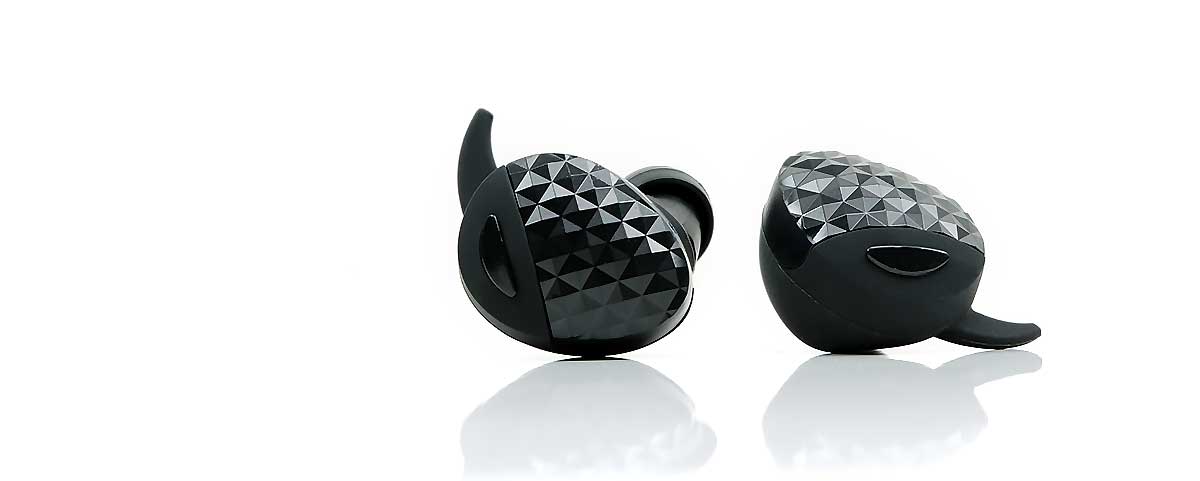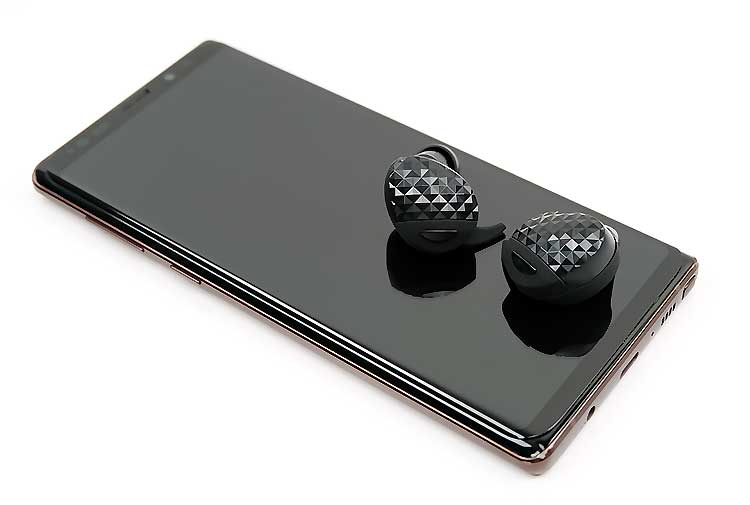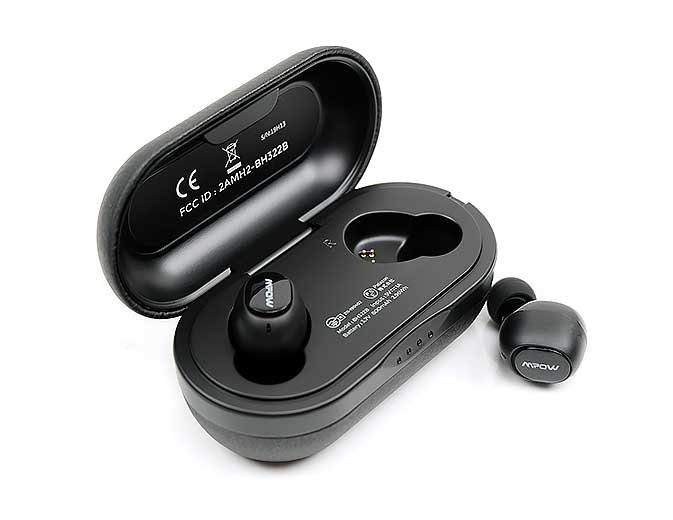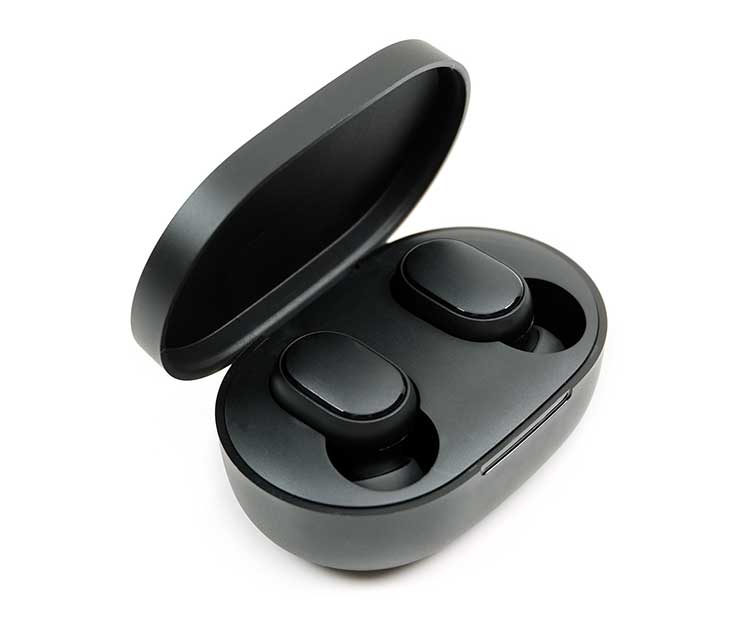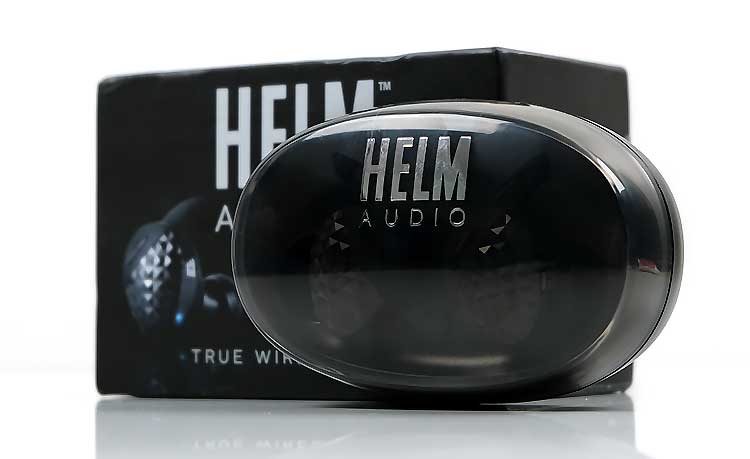Sound Impressions
Summary
The HELM TW5.0 is a V-shaped and bass-heavy TWS. So far, it is the heaviest low-end driver tuning I have heard from these systems to date.
No question it is dynamic driver timbre all the way with plenty of mid-bass bloom, an elevated sub-bass presence, and a long decay. I thought the M5 was heavy and thunderous but the TW5.0 is much more so.
Combine that with a 1-3k rise and a coherent treble with some light contrast and you could define the TW5.0 as a bit more to the warm side but not quite what I would normally define as dark in character. The treble does have some lift, perhaps closer to the 8k marker but it is not a steely sound like the EW1 and not as forward either.
Vocals have a forward nature to them though the mids overall play second fiddle for instrumental weight and presence. You get plenty of bass fundamental but not so much body or huge separation, especially in the lower-mids. This is where the EW1 has an advantage over these more consumer-style bass-heavy tunings.
Having said that the wetter more forgiven treble of the TW5.0 delivers a more listenable percussion than the EW1 which at times just sounds strange or unnatural.
The dynamic range on the TW5.0 is on par with the MPOW M5 and EW1 and better than the KZ T1 and Airdot’s more compressed sound. I have no issues with the TW5.0 aptX quality of delivery in the context of the previous units we have reviewed.
Timbre
The TW5.0 timbre is warm, slightly euphonic with plenty of bass fundamental driver PRaT. Upper-order harmonic presence is somewhat neutral with just enough contrast to prevent the tuning from sounding dull or blunted.
That being said it is more even than odd-harmonic in its balance so vocals have a euphonic quality to them. Sibilance is not an issue here but some more air would have been appreciated.
Percussion timbre and anything pitching in the upper mids are wetter and smoother sounding than the edgier EW1 but not quite as natural for me as the M5 which dials back on the mid-bass bloom to allow the mids to breathe a little better.
Staging
The HELM TW5.0 is more about the depth than the height with a forward vocal presence that just about balances out the low end in terms of being heard.
Height is okay actually. It is not overly attenuated but it does play second fiddle to that bass-centric tuning. That means you will not be focusing too much on the finer qualities of some sort of ethereal treble or a high-fidelity overtone. Your ears will be focusing far further south than that.
The V-shaped dip will stretch the soundstage but it is not hugely distant or disconnected. I have heard worse in terms of mids suck-out but don’t expect instruments to be front and center. Look to the EW1 for a better lower-mid instrumental presence. Vocal clarity is good, with female vocals, in particular, sounding full and forward on the TW5.0.
I find when the mix is stripped down the TW5.0 staging fares much better. Tracks like The Gossip’s Standing in the Way of Control (Playgroup remix) with its percussion-driven bass synth and Beth Dittos’ almost Joplin-like performance sound powerful and clear on the TW5.
Wireless Performance
Pairing
As mentioned in the controls section, the TW5.0 pairing is fiddly and slightly OCD but once you familiarize yourself with the manual and process it works without an issue. Just remember to take out the left first, wait for the voice assistant to say pairing then take out the right and the TWS is ready to pair to a source.
The master driver on the TW5.0 is left and not the usual right so do not go looking for the right initially. Pair with the left and all will follow smoothly. At the time of writing, the TW5.0 cannot connect to multiple devices at the same time so if you like to switch around then you have to disconnect from one source and pair with another.
Stability
HELM was not kidding regarding the extended reception potential of the TW5.0. I can get further without loss of stability on the TW5.0 compared to any other TWS I have reviewed to date.
I have this little corner of the kitchen I cannot get into about 10-12 meters away from a Samsung Note 9 without breaking up on all other TWS. Not so with the TW5.0. I was able to cruise into the kitchen corner without a single signal drop.
Outside the house and using straight-line walking I was able to go about 20-25m before the signal got choppy using both a Huawei P20 and Samsung Note 9. You have to remember this is with aptX so that’s a good performance rating for me in terms of distance and stability.
Latency
Paired with a Windows 10 PC the latency was lower than the MPOW M5 and the EW1, the two competing aptX TWS systems. With the M5 and EW1, we had to push the audio forward by 0.2s to properly sync with the video.
However, testing a 448 Kbps AC3 5.1 encoded movie proved to require no latency adjustment for the TW5.0. Overall, this is a better wireless movie-watching experience.
Comparison Ladder
Jade Audio EW1
$32.99 – US $62.48
Technical
The EW1 is significantly cheaper and in some ways looks it with its non-descript black jellybean design, creaky charging cable lid, and plastics. However, it is smaller, lighter, and has a ton of competing features.
This includes a Qualcomm QCC3020 chipset with aptX, AAC, and BT5.0. The EW1 also has a grade higher IPX5 compared to the HELM TW5.0 IPX4. Whilst only the EW1 pitches cVc 8.0 noise-suppressing capability, I am fairly sure the TW5.0 has it also since both share the same chipset.
Charging capability between the two of the units is close at 6-7 hours for the EW1 and 6-8 for the HELM TW5.0. I give the edge though to the HELM for the massive 30-40 charging case capability. You will find the TW5.0 in the cradle a lot less than the Jade and with more potential cycles before charging the case. Which is just as well as both use micro USB.
One final note on isolation. The TW5.0 is vastly superior to the EW1. The tips are so so on both but I think it is how the TW5.0 sits in my ear combined with the materials that makes it better. They feel grippier than the shiny smooth EW1 and they may help to block out more noise.
Performance
Much better stability and distance from the TW5.0 compared to the EW1. The EW1 will go close but drops its signal in that kitchen corner and comes up a few meters shorter in a straight line compared to the TW5.0.
Both have weaker performances from DAPs such as the iBasso DX160 and HiBy’s R5 but that’s entirely due to the weaker signal strength from those two sources compared to the Note 9 and P20. However, the TW5.0 did have better stability and range of the two TWS.
Tuning
The bass is immense on the TW5.0 compared to the EW1. No question which is the more powerful.
The treble on the EW1 is also a lot steelier and grating compared to the slightly more relaxed and wetter tone of the TW5.0 top-end. I find the TW5.0 treble fade to be more forgiving but you could argue it has a slightly darker presentation as a result. If EDM is your bag then the power of the TW5.0 is much more convincing.
However, the EW1’s slightly tamer low-end allows the more forward mids to shine. Vocals have a shade more clarity and room to breathe on the EW1 despite the better timbre on the TW5.0. That’s primarily a weakness of having almost too much bass on the TW5.0.
I would have to EQ 20-100Hz down by 2-3dB on the TW5.0 a bit to open up the mids and allow them to breathe a little better for vocals to shine a bit more.
So I prefer the timbre and fullness of the TW5.0 compared to the strange treble overtone of the EW1. However, I prefer the mids positioning in the EW1 soundstage and less dominant bass allowing those mids to breathe compared to the ground and pound of the TW5.0 low-end.
If I am on EDM and synth-wave I am all for the TW5.0 power but trickier mid-centric indie and rock stuff has me switching to the EW1 with a tiny bit of treble EQ.
MPOW M5
$49.99
Technical
As with the HELM TW5.0, the MPOW M5 uses a single dynamic driver combined with a lot of overlapping wireless features. It is also less than half the price of the HELm TW5.0.
This includes BT5.0, cVc 8.0 noise suppression, weather resistance IPX rating, and independent bud control. Do note, however, that the M5 IPX rating is an excellent IPX7 compared to the TW5.0 IPX5. If you plan to run your head under a faucet the M5 is the way to go. Otherwise, both are solid gym contenders for sweat and fitness ‘gunk’.
Design-wise, the TW5.0 stomps all over the cheapness of the M5 look and feel. I actually believe in the IPX rating of the TW5.0 more than the M5 with that rubbery finish.
The shark fin ear holder also helps secure the TW5.0 better in the ear than the M5. Mind you, not that the M5 is loose but the TW5.0 is rock solid. The TW5.0 isolation is also a few grades higher than the M5 using the stock tips.
On the flip side, I much prefer the smaller M5 charging case and driver form factor. The TW5.0s are big and the cradle is equally so. Battery life on both is strong. You get 5-6 hours on the M5 and the real-world performance is close.
However, the TW5.0 is ahead by 6-8 hours per cycle. Both have a 30+ rated cradle so it’s hard to gauge exactly which has more as the TW5.0 parameter is quite large at 30-40 hours. Both use micro USB so, yeah…
Performance
I won’t repeat myself on relative stability and performance on the smartphones as the TW5.0 was better. What I did want to focus on was the Lotoo PAW Gold Touch performance. The M5 keeps dropping this connection and cycling through a pairing process with the Touch. This makes it unplayable, even at close range.
The TW5.0 was rock steady without a single drop during the time I used them for this review. I was beginning to think the PAW Touch was the issue but it seems the actual TWS itself has a bigger role in the stability of this pairing.
Tuning
Whilst both are aiming for a similar bass-orientated V-shaped experience there are some tuning differences between these two. For a start, the TW5.0 has a bit more warmth and bloom in its low end whereas the M5 is cooler and with more sub-bass bias over its mid-bass bloom.
Overall, the TW5.0 bass has more quantity for me but the M5 sounds a shade tighter and bleeds a bit less into the mids. The M5 lower-mids and vocals sound more centered with a bit more focus as a result.
The TW5.0 timbre is a little on the warmer side also which is no surprise given the additional bloom creeping up into the upper bass and lower-mids. There is some good treble contrast so notes do not sound overly rounded. Vocals on both have a similar positioning with a slightly forward experience and nothing terribly recessed.
The initial perception of a better treble presence on the M5 is misleading. It is not as extended or as clean as the TW5.0 but the TW5.0 bass bloom dominates more than the M5. That means you tend to notice its treble performance a little less. Listen carefully and it will sound a bit cleaner and more articulate compared to the M5.
Redmi Airdots
$29.99
Technical
Instead of the discontinued KZ T1, the Airdots get a look-in this time since they are even cheaper than SRP these days and use a similar dynamic driver setup to the TW5.0.
I cannot overemphasize the attractiveness of simplistic pairing without the hassle and the Airdots with the M5 are by far the easiest TWS to pair with sources. The TW5.0 can be fiddly if you do not follow the strict pairing process but none are as frustrating as the KZ T1.
No question the Airdots are the smallest we have for both charging cases and drivers. They make the TW5.0 and its cradle looks huge side by side.
However, the battery life on the Airdots is vastly inferior at just 4 hours per driver and 16 hours of total cradle capacity. The TW5.0 stomps all over the Airdots with almost double the battery life. Big advantage there for me.
Feature-wise, the Airdots has some but not all of the TW5.0 features. Both have IPX4 element resistance, both have BT5.0 with independent driver control and an element of noise suppression. The two TWS also have physical controls as opposed to touch controls.
However, the Airdots do not have aptX or AAC so higher rates of compression compared to the TW5.0. It also has more limited controls with no volume control which means the source is not going to be too far from you.
Performance
Pairing is more fluid with the Airdots with the right side being the master driver. However, I find the pairing on the Airdots to be less fussy compared to the TW5.0 and you will find yourself having to reset a little less at the start of using them.
Stability and performance are better on the TW5.0. You can go further with less dropout on the TW5.0 and this is on aptX compared to just SBC on the Airdots.
Tuning
In terms of the driver size the Airdots actually has the bigger single dynamic driver of the two at 7.2mm compared to 6.8mm but you would not think that when listening to both of them.
Some of that is due to the better decoding rates of the TW5.0 with aptX as opposed to SBC only from the AirDots. You can really pick up quite easily on the enhanced dynamic range and more open sound of the TW5.0. The rest is simply tuning and quality of the driver and IMHO the HELM TW5.0 has the better driver.
The TW5.0 is a bit more full-bodied and warmer across the FR with slightly more treble fade than the Airdots. The Airdots are a little grainier and drier sounding with more upper-mids ‘shoutiness’ and a bit more treble infusion also.
The TW5.0 has a more euphonic timbre with a slightly wetter upper mids and more forgiving treble reproduction. Certainly, it is more even-harmonic in its balance than the Airdots which can be edgier sounding from the mids upwards.
For the low-end, the HELM TW5.0 is more powerful sounding with more sub-bass dynamic range and quantity. That delivers a more gripping fundamental to lower-pitching instruments compared to the Airdots.
Now, I always considered the Airdots to be fairly strong on the sub-bass performance but beyond that, the mid-bass has no warmth. The TW5.0 has a bit more warmth and that helps flesh out the instrumental timbre a lot more.
Our Verdict
In terms of technical excellence, the TW5.0 is top of the tree so far in our TWS reviews for features. In particular, the battery life, stability, and range of its BT5 implementation are excellent. Certainly, the TW5.0 outperforms the cheaper models by some margin.
Tonally, it is big on the bass, perhaps the biggest I have heard so far. That’s a strength and flaw and will clearly appeal to EDM and some synth-wave fans who place a little less emphasis on mids mid-instrumental presence. Less so for mids guys.
One final shout-out to that wicked level of isolation. That is what I would expect from good audiophile IEMs so I hope to see that continue on any new models they bring out. In all, a ‘dyed-in-the-wool’ basshead audio experience with some audiophile expectations met for fitting and wireless performance from the HELM True Wireless 5.0.
HELM True Wireless 5.0 Specifications
- Custom polymer and alloy-enhanced 6.8mm Single Dynamic Drivers
- Bluetooth version: 5.0
- Proprietary HELIX Antenna for Extended Range 60+ft
- Wireless type: EDR + Bluetooth
- Sensitivity: 88 ±3dB
- Resistance: 16 ohms
- Standby time: 100 hours
- Playtime: 6–8 hours
- Case recharges 4x
- Playtime with charging case: 30–40 hours (based on volume level)
- Charging time: 1.5 hours
- Microphone: Built-in microphone on each earpiece
- Smart button control-equipped
- IPX4 water-resistant
- Auto-pairing
- Auto-charging
- Qualcomm aptX™, AAC
- New dual stereo mics

